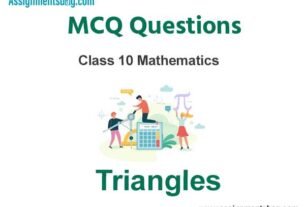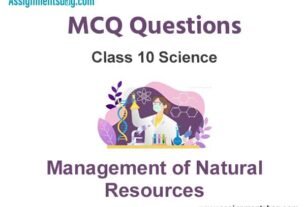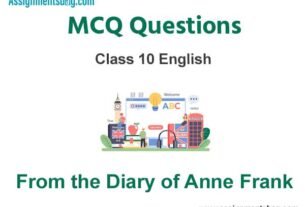Please refer to MCQ Questions Chapter 12 Electricity Class 10 Science with answers provided below. These multiple-choice questions have been developed based on the latest NCERT book for class 10 Science issued for the current academic year. We have provided MCQ Questions for Class 10 Science for all chapters on our website. Students should learn the objective based questions for Chapter 12 Electricity in Class 10 Science provided below to get more marks in exams.
Chapter 12 Electricity MCQ Questions
Please refer to the following Chapter 12 Electricity MCQ Questions Class 10 Science with solutions for all important topics in the chapter.
MCQ Questions Answers for Chapter 12 Electricity Class 10 Science
Question:

represents _______________ in an electric circuit.
(a) electric resistor
(b) electric cell
(c) variable resistant
(d) voltmeter
Answer
B
Question: A body can be negatively charged
(a) Giving electrons to it
(b) removing some electrons from it
(c) giving some protons to it
(d) removing some neutrons from it
Answer
A
Question: One ampere is equal to
(a) 1 C/s
(b) 1Cx1s
(c) 1Jx1C
(d) 1J/C
Answer
A
Question: _____________ is the amount of charge flowing through a particular area of cross section of aconductor in unit time.
(a) Charge
(b) electric current
(c) potential
(d) Energy
Answer
B
Question: The unit of charge is
(a) Ampere
(b) Coulomb
(c) Farad
(d) Volt
Answer
B
Question: No current flows between two charged bodies when connected , if they have same
(a) Capacity
(b) potential
(c) charge
(d) none
Answer
B
Question: The surface of the earth is taken to be at
(a) infinite potential
(b) negative potential
(c) positive potential
(d) zero potential
Answer
D
Question: The SI unit of electric current is
(a) Ohm
(b) Volt
(c) Ampere
(d) Coulomb
Answer
C
Question: Which is bigger: a coulomb of charge or the charge of an electron?
(a) Coulomb of charge
(b) Charge of an electron
(c) Both are same
(d) None
Answer
A
Question: The SI unit of potential difference
(a) Ohm
(b) Volt
(c) Ampere
(d) Coulomb
Answer
B
Question: What is the work done in moving a charge of Q coulomb against a potential difference of V volt?
(a) Q/V
(b) QV
(c) Q+V
(d) Q-V
Answer
B
Question: Volt is the SI unit of
(a) potential difference
(b) current
(c) resistance
(d) charge
Answer
A
Question: What is the instrument used to measure potential difference across a circuit?
(a) Ammeter
(b) Voltmeter
(c) Galvanometer
(d) All
Answer
B
Question: The device used for measuring current is
(a) Galvanometer
(b) ammeter
(c) voltmeter
(d) potentiometer
Answer
B
Question: How many electrons are equals to 1 coulomb?
(a) 6.25 x 1016
(b) 6.25 x 1017
(c) 6.25 x 1018
(d) 6.25 x 1019
Answer
C
Question: ___________between two points in an electric circuit carrying some current as the work done to move a unit charge from one point to the other.
(a) Electric current.
(b) electric charge
(c) potential difference
(d) electric power
Answer
C
Question:

represents _______________ in an electric circuit.
(a) electric resistor
(b) electric ell
(c) plug key
(d) voltmeter
Answer
C
Question:

represents _______________ in an electric circuit
(a) wire crossing with joint
(b) electric cell
(c) variable resistance
(d) wire crossing without joint
Answer
D
Question: A continuous and closed path of an electric current is called an
(a) electric diagram
(b) electric circuit
(c) electric ray diagram
(d) all
Answer
B
Question. The resistance of wire is 20Ω. The wire is stretched to three time its length. Then the resistance will now be
(a) 6.67 Ω
(b) 60 Ω
(c) 120 Ω
(d) 180 Ω
Answer
D
Question. In the circuit shown in the figure, the current through
(a) the 3Ω resistor is 0.50A
(b) the 3Ω resistor is 0.25A
(c) the 4Ω resistor is 0.50A
(d) the 4Ω resistor is 0.25A
Answer
D
Question. When the resistance of copper wire is 0.1 Ω and the radius is 1 mm, then the length of the wire is (specific resistance of copper is 3.14 × 10–8 ohm × m)
(a) 10 cm
(b) 10 m
(c) 100 m
(d) 100 cm
Answer
B
Question. When the resistance wire is passed through a die the crosssection area decreases by 1%, the change in resistance of the wire is
(a) 1% decrease
(b) 1% increase
(c) 2% decrease
(d) 2% increase
Answer
D
Question. The lowest resistance which can be obtained by connecting 10 resistors each of 1/ 10 ohm is
(a) 1/ 250Ω
(b)1/200Ω
(c) 1/100Ω
(d) 1/10 Ω
Answer
B
Question. The resistance 4R, 16R, 64R, ……….∞ are connected in series, their resultant will be
(a) 0
(b) ∞
(c) 4/3 R
(d) 3/4 R
Answer
B
Question. Resistance R, 2R, 4R, 8R ………….. ∞ are connected in parallel. Their resultant resistance will be
(a) R
(b) R/2
(c) 0
(d) ∞
Answer
B
Question. The equivalent resistance between points X and Y is

(a) R
(b) 2R
(c) R/2
(d) 4 R
Answer
B
Question. The electric resistance of a certain wire of iron is R. If its length and radius are both doubled, then
(a) The resistance will be doubled and the specific resistance will be halved
(b) The resistance will be halved and the specific resistance will remain unchanged
(c) The resistance will be halved and the specific resistance will be doubled
(d) The resistance and the specific resistance, will both remain unchanged
Answer
B
Question. The equivalent resistance between points A and B is

(a) 4Ω
(b) 4.5 Ω
(c) 2 Ω
(d) 20 Ω
Answer
B
Question. There are two wires of the same length and of the same material and radial r and 2r. The ratio of their specific resistance is
(a) 1 : 2
(b) 1 : 1
(c) 1 : 4
(d) 4 : 1
Answer
B
Question. Three resistances 4Ω each of are connected in the form of an equilateral triangle. The effective resistance between two corners is
(a) 8Ω
(b) 12Ω
(c) 3/8 Ω
(d) 8/3 Ω
Answer
D
Question. The heating element of an electric heater should be made with a material, which should have
(a) high specific resistance and high melting point
(b) high specific resistance and low melting point
(c) low specific resistance and low melting point
(d) low specific resistance and high melting point
Answer
A
Question. Two wires of same metal have the same length but their cross-sections area in the ratio 3 : 1. They are joined in series. The resistance of the thicker wire is 10Ω. The total resistance of the combination will be
(a) 40 Ω
(b) 40/3 Ω
(c) 5/2 Ω
(d) 100 Ω
Answer
A
Question. A certain piece of silver of given mass is to be made like a wire. Which of the following combination of length (L) and the area of cross-sectional (A) will lead to the smallest resistance
(a) L and A
(b) 2L and A/2
(c) L/2 and 2A
(d) Any of the above, because volume of silver remains same
Answer
C
Question. Which one of the following heater element is used in electric press
(a) copper wire
(b) nichrome wire
(c) lead wire
(d) iron wire
Answer
A
Question. A certain wire has a resistance R. The resistance of another wire identical with the first except having twice of its diameter is
(a) 2 R
(b) 0.25 R
(c) 4 R
(d) 0.5 R
Answer
B
Question: The SI unit of resistance is
(a) Volt
(b) Ohm
(c) Ampere
(d) Watt
Answer
B
Question:

represents _______________ in an electric circuit.
(a) electric resistor
(b) electric cell
(c) variable resistance
(d) voltmeter
Answer
C
Question: A device used to change the resistance of a circuit is _______________.
(a) Ammeter
(b) Voltmeter
(c) Rheostat
(d) Galvanometer
Answer
C
Question:

represents _______________ in an electric circuit.
(a) Electric bulb
(b) Electric cell
(c) Variable resistance
(d) Electric resistor
Answer
A
Question: The resistances R1 and R2 are connected in parallel. The equivalent resistance of the combination is
(a) R1 + R2
(b) R1 – R2
(c) R1R2/R1+R2
(d) R1+R2/R1R2
Answer
C
Question: The electrical appliances in the houses are connected with each other in
(a) Parallel
(b) Series
(c) a combination of series and parallel circuits
(d) none
Answer
A
(a) If both Assertion and Reason are correct and Reason is the correct explanation of Assertion.
(b) If both Assertion and Reason are correct, but Reason is not the correct explanation of Assertion.
(c) If Assertion is correct but Reason is incorrect.
(d) If Assertion is incorrect but Reason is correct.
Question. Assertion : Wire A is thin in comparison to wire B of same material and same length then resistance of wire A is greater than resistance of wire B.
Reason : Resistivity of wire A is greater than resistivity of wire B.
Answer
C
Question. Assertion : Fuse wire must have high resistance and low melting point.
Reason : Fuse is used for very small current flow only.
Answer
C
Question. Assertion : Positive charge inside the cell always goes from positive terminal to the negative terminal.
Reason : Positive charge inside the cell may go from negative terminal to the positive terminal.
Answer
D
Question. Assertion : If ρ1 and ρ2 be the resistivities of the materials of two resistors of resistances R1 and R2 respectively and R1 > R2, then ρ1 > ρ2.
Reason : The resistance R = p = 1/A ⇒ ρ1 > ρ2 if R1 > R2
Answer
D
Question. Assertion : In a simple battery circuit, the point of lowest potential is negative terminal of the battery.
Reason : The current flows towards the point of higher potential as it flows in such a circuit from the negative to positive terminal.
Answer
C
Question. Assertion : When current through a bulb decreases by 0.5%, the glow of bulb decreases by 1%.
Reason : Glow (Power) which is directly proportional to square of current.
Answer
B
Question. Assertion : Alloys are commonly used in electrical heating devices like electric iron and heater.
Reason : Resistivity of an alloy is generally higher than that of its constituent metals but the alloys have low melting points than their constituent metals.
Answer
C
ONE MARK QUESTIONS
Question: Three resistors of resistances 5 ohm, 10 ohm and 15 ohm are connected in series. The effective resistance of the combination is _______
Answer
5 + 10 + 15 = 30 ohm
Question: In a circuit, two resistors of 5 Ω and 10 Ω are connected in series. The ratio of current passing through each resistor is _______
Answer
1: 1
Question: _______is same for all the resistors connected in series.
Answer
current
Question: _______is same for all the resistors connected in parallel combination.
Answer
potential difference
Question: I1, I2, and I3 are the respective currents passing through the three resistances connected in parallel. The total current entering in or going out of the circuit is _______
Answer
I = I1 + I2 + I3
Question: R1 and R2 are the two resistances connected in parallel. The total resistance of the combination of resistors is _______
Answer
R1R2/R1+R2
Question: If more than one resistances are connected between two points, then we say that the resistances are connected in _______
Answer
parallel
Question: The ratio of potential difference across the two resistors connected in parallel is equal to _______
Answer
1: 188.
Question: An ammeter is connected in _______in a circuit.
Answer
series
Question: Voltmeter is connected in _______in a circuit.
Answer
Parallel
Question: 1 kWh = _______J 3.6 x 106 J
Answer
3.6 x 106 J
Question: The resistance of the conductor becomes _______when its area of cross section is increased.
Answer
Decreases
Fill in the Blanks :
Question. The S.I. unit of resistivity is ………….. .
Answer
ohm-meter
Question. 1 kW h = ………..
Answer
3,600,000 J
Question. Physical quantity represented by coulomb per second is …………… .
Answer
electric current
Question. The rate of flow of electric charge is called ……………..
Answer
electric current
Question. Kilowatt is the unit of electrical ………….. but kilowatthour is the unit of electrical ………………
Answer
power, energy
Question. Energy spent in kilowatt-hour volt ×……….×………./100 .
Answer
ampere, hour
Question. Copper is a preferred material for making wire because of its low……………………
Answer
resistivity
True / False :
Question. The equivalent resistance of several resistors in series is equal to the sum of their individual resistances.
Answer
True
Question. The reciprocal of resistance is called specific resistance.
Answer
False
Question. The resistivity of all pure metals increases with the rise in temperature.
Answer
True
Question. Resistivity is measured in ohm-metre.
Answer
True
Question. The commercial unit of electrical energy is kilowatt-hour (kWh).
Answer
True
Question. Pure tungsten has high resistivity and a high melting point (nearly 3000°C).
Answer
True

We hope you liked the above provided MCQ Questions Chapter 12 Electricity Class 10 Science with solutions. If you have any questions please ask us in the comments box below.


